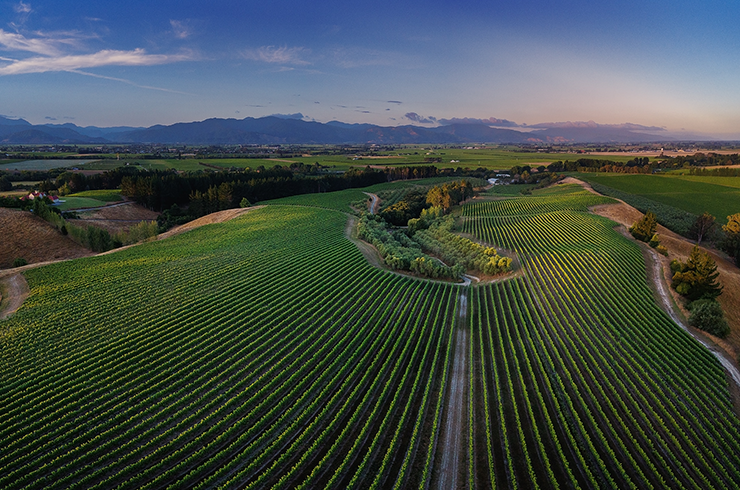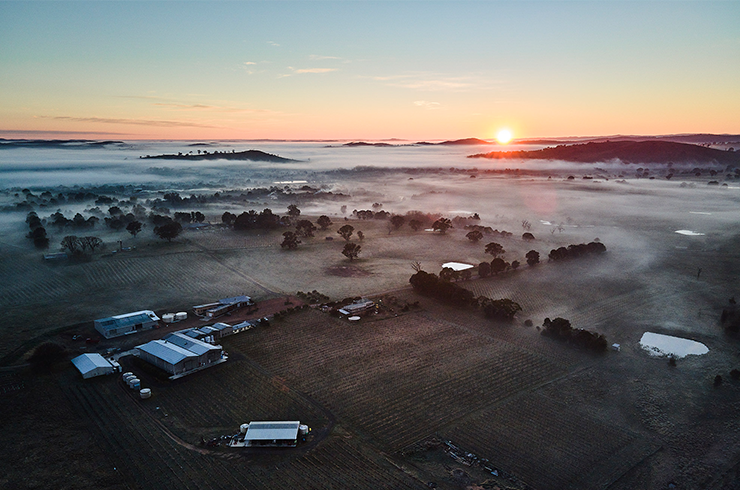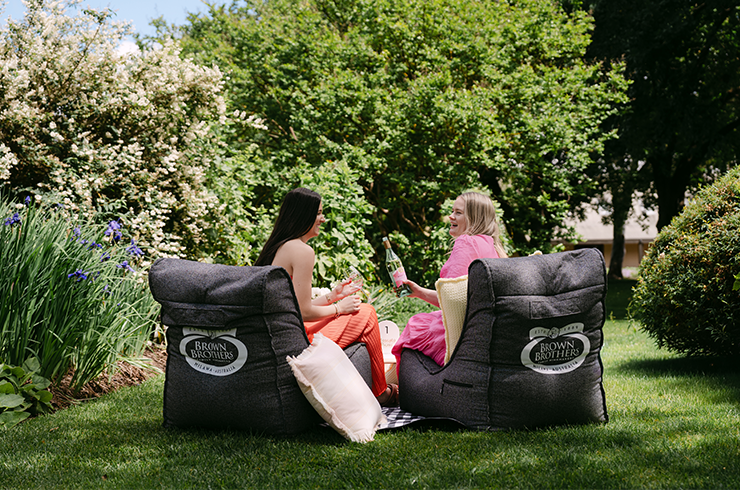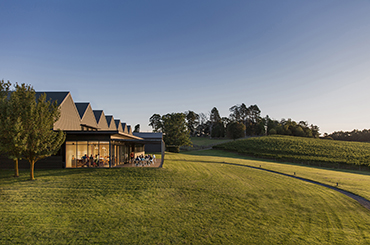This profile first appeared in the February/March 2017 issue of Halliday magazine.
“My grandfather migrated to Australia from Ukraine just after WWII and planted a vineyard in the Clare Valley.
When I was young, we’d go there and I’d help him pick grapes, and sometimes I’d drive the tractor – until I’d take a vine out and be back on the snips. My dad and uncles would work there all weekend, and there’d be long lunches where we’d drink wine out of recycled Vegemite glasses. They sold that [property] in the ’80s when he passed, but I suppose that sparked my interest in wine.
When I finished school, I did a degree in hospitality management and was halfway through before I realised it wasn’t for me. While I was doing that, I undertook all of the wine subjects I could and developed a real passion for it. All of my peers went off and became food and beverage managers in big hotels, and I went and worked in a pruning gang in McLaren Vale. I loved it. I was up early, in nature and working with my hands. I did that from my early 20s and eventually got a job as a vineyard hand. Soon enough, I was managing vineyards.
The world wanderer
I began doing vintages overseas, mainly in California. I’d do a vintage in the Adelaide Hills and one in California. Here, I’d work in the vineyard and there, I’d work in the winery. I did that for four or five years, working with the same winemaker overseas. I bought a Kombi so I could explore on weekends, and my girlfriend [now wife Amber] would come over from London to surf down in Mexico and go to festivals like Burning Man. I realised I loved working in the winery and making wines, so I went to Roseworthy to study oenology and viticulture. Once I’d finished, I began working as an assistant winemaker at Two Hands in the Barossa Valley. Before that, I worked at Nepenthe. I saw a job advertised that said something like, ‘Requiring flying winemaker to work throughout Europe, based in Sweden.’ I fluffed up my resume, applied and got the job.
I worked as a flying winemaker for about three years, putting blends together for a big company that sold wine to Scandinavia. My main job was to make a million litres of chardonnay each year in Puglia in Italy. I got the company to fly a few friends over to help, such as Nick McNally and Emily Laughton [of Jasper Hill], and, of course, Amber. We spent a lot of time having long lunches, checking on vineyards and making this chardonnay.
That experience of making bulk, factory-style wine didn’t satisfy my creative instincts at all. I always dreamed of having my own little winery that produced small batches of handmade wines using fruit from excellent vineyards where everything was grown organically. I wanted to employ a holistic approach to winemaking, and because I’d spent so much time in Europe, I loved European-style wines, specifically Beaujolais and Chablis. So I tried to mimic that style of wine, which was quite different to the wines being made in Australia at the time.
“My grandfather migrated to Australia from Ukraine just after WWII and planted a vineyard in the Clare Valley.
When I was young, we’d go there and I’d help him pick grapes, and sometimes I’d drive the tractor – until I’d take a vine out and be back on the snips. My dad and uncles would work there all weekend, and there’d be long lunches where we’d drink wine out of recycled Vegemite glasses. They sold that [property] in the ’80s when he passed, but I suppose that sparked my interest in wine.
When I finished school, I did a degree in hospitality management and was halfway through before I realised it wasn’t for me. While I was doing that, I undertook all of the wine subjects I could and developed a real passion for it. All of my peers went off and became food and beverage managers in big hotels, and I went and worked in a pruning gang in McLaren Vale. I loved it. I was up early, in nature and working with my hands. I did that from my early 20s and eventually got a job as a vineyard hand. Soon enough, I was managing vineyards.
The world wanderer
I began doing vintages overseas, mainly in California. I’d do a vintage in the Adelaide Hills and one in California. Here, I’d work in the vineyard and there, I’d work in the winery. I did that for four or five years, working with the same winemaker overseas. I bought a Kombi so I could explore on weekends, and my girlfriend [now wife Amber] would come over from London to surf down in Mexico and go to festivals like Burning Man. I realised I loved working in the winery and making wines, so I went to Roseworthy to study oenology and viticulture. Once I’d finished, I began working as an assistant winemaker at Two Hands in the Barossa Valley. Before that, I worked at Nepenthe. I saw a job advertised that said something like, ‘Requiring flying winemaker to work throughout Europe, based in Sweden.’ I fluffed up my resume, applied and got the job.
I worked as a flying winemaker for about three years, putting blends together for a big company that sold wine to Scandinavia. My main job was to make a million litres of chardonnay each year in Puglia in Italy. I got the company to fly a few friends over to help, such as Nick McNally and Emily Laughton [of Jasper Hill], and, of course, Amber. We spent a lot of time having long lunches, checking on vineyards and making this chardonnay.
That experience of making bulk, factory-style wine didn’t satisfy my creative instincts at all. I always dreamed of having my own little winery that produced small batches of handmade wines using fruit from excellent vineyards where everything was grown organically. I wanted to employ a holistic approach to winemaking, and because I’d spent so much time in Europe, I loved European-style wines, specifically Beaujolais and Chablis. So I tried to mimic that style of wine, which was quite different to the wines being made in Australia at the time.

I wanted to make something raw, with great energy and nervous tension from fruit picked early – the kind of wine that makes you hungry.
I wanted to make something raw, with great energy and nervous tension from fruit picked early – the kind of wine that makes you hungry. I suppose that stemmed from developing a cellar palate. After a long time working in wineries, because you taste wines that are young and raw, you start to think they’re ready a lot sooner. Instead of leaving wines in barrel for ages and using lots of oak, I wanted to make wines closer to what you would taste out of the barrel.
The story behind the name
 The Ochota Barrels logo, designed with the help of calvados one cold, Swedish night. Image: @ochotabarrels
The Ochota Barrels logo, designed with the help of calvados one cold, Swedish night. Image: @ochotabarrels
I had a misspent youth playing in punk bands. We did it for about six years, touring the country and playing festivals like Big Day Out. I’ve also surfed all my life, which influenced the name. ‘Barrels’ doesn’t refer to barrels of wine, but rather surfing barrels. Ochota is obviously my surname and loosely translates to ‘desire’. All of the names for my wines are taken from punk songs, so basically it includes my three interests – surfing, punk music and wine. They all came together naturally, which is nice because I’ve been able to scratch that creative itch. I designed the logo for the wines one cold, Swedish night while drinking calvados. It’s meant to represent the simplicity of the journey from the soil to the vine, the grapes and the bottle, without manipulation or modification.
The philosophy
I love wines that are clean, pure and delicious. Technically, they are ‘natural’ wines, but I’m not a big fan of that term; it bores and irritates me a bit, as there’s a snobbery attached to it that’s quite unattractive. The analogy I like to use is that we have a veggie garden, and my son, Sage, can pick a cherry tomato and eat it without us worrying about washing it. It’s the same principle with my wines.
I’ve always admired winemakers who could just let things go. If you can do it tomorrow, do it tomorrow – it might make better wine. Winemaker Seth Kunin was a great mentor for me, a chilled-out guy I worked with in Santa Barbara. He’d check the surf report and if it were good, he’d say, ‘We’re going for a surf and then we’ll go to work.’ Sometimes we wouldn’t get to work until lunchtime and then he’d want to get back out there in the evening. His ethos was an inspiration to me. I’d worked at wineries around the world where vintage was very stressful. As I progressed through my career, managing 20-odd staff and doing 16-hour days, seven days I week, I would become really anxious in the lead-up to vintage. Since starting Ochota Barrels, I’ve only worked past 6pm once or twice. I try to keep it simple. If I’ve got a beer in my hand at 5pm, I’m happy.
A place to call home
I’m from Adelaide and worked in the vineyards of the Adelaide Hills through the ’90s. In my opinion, it’s the most beautiful part of South Australia. There’s a great little community in the Basket Range. We live on a dirt road with a creek flowing through, fruit and nut trees, plenty of wildlife and some forest, but in 20 minutes I can be in Adelaide’s Central Market eating pho. It’s the best of everything.
 Fun in the winery. Image credit: Amber Ochota
Fun in the winery. Image credit: Amber Ochota
The winery is just a shed. It has no insulation because trees shade it. I don’t have much equipment – I have a crusher that was given to me by Ron and Emily Laughton, their original one from Beaune in France, plus a basket press and forklift. It’s all secondhand. I’ve got a small lab where I can test for pH, sulphurs and acids to make sure I’m on the right track. My technique for heating and cooling is to put the fermenter into the sun or take it into the cool part of the winery. Most of our ferments are warm, so the sun is my friend. The way I make, say, gewurztraminer is to do everything opposite to what I learnt at university. Doing things differently helps me create my own signature style. If it’s a nice vineyard and fruit, if you keep things simple and focus on the texture, hopefully, you’ll make delicious wine.
The winemaking and wines
I make decisions in the winery by tasting blind – I just trust my palate. I keep different vineyards and cuvees separate, so if there’s a barrel that’s not working, I can blend it. I have about 100 seasoned, French barriques each filled with something different. They’re small vessels, don’t impart any flavour and give you a lot more options. I wouldn’t like to put all my eggs in one basket, like a large foudre, when I don’t know how it’s going to turn out. So I keep lots of half-tonne fermenters separate so that when I put the blend together, I have a bit more control because I can hopefully use those different components to contribute more complexity. I pick fruit based on natural acidity and then try to really under-extract it to make light, delicious wines that are in balance. I use a lot of whole bunches because I love what that contributes to the aromatics and tannin profile, which is sort of like gravel. The big stones are what I think of as being the tannins from the skins, and the smaller, sandier pebbles are the tannins from the stalks. Combined, they create a lovely matrix over the palate that coupled with natural acidity makes for a piquant little bomb of a wine. Besides my amazing dad, who loves being paid in wine, and my incredible, patient wife, I hadn’t had staff until recently when I employed a friend to help me out. Keeping the operation small means that I can maintain that attention to detail in every step and become intimate with every barrel.
Grenache is where we started and we work with three different vineyards, all planted in the ’40s. They’re beautiful old vines that thankfully missed the vine-pull scheme. All of my grenache vineyards are on the way to a little surf spot from Basket Range to Blewitt Springs, which is how I found them. The other wine that’s central to what we do is gamay. On the top plateau of our 10-acre property in Basket Range are three clones of single-staked, goblet-trained gamay. The soil profile there is amazing – a lot of quartz, ironstone and sandstone – and it’s a beautiful north-facing site about 400 metres above sea level.
All of my growers are friends. We have a gentleman’s handshake agreement and I pay them straight away, which is quite uncommon. They get cut short sometimes, the old growers, so I like to help mine out. And I take from the same sections of the same vineyards every year. Most have been doing what they do their whole lives. Some are 70-year-old vines. They’re all organic operations. They’re mostly in the Adelaide Hills, with a couple in McLaren Vale and one in the Barossa Valley.
We make 18 labels, and some might only be 300 bottles. We also export to 16 countries, and it can be difficult to tell a distributor they can only have 24 bottles. But I cut up the pie and share it, and it’s a great excuse to visit our international markets – Japan, Norway and the US are our biggest.
Winemaking is a nice balance of science and art, but as you become more experienced, the science becomes automatic and you have a clearer canvas to work creatively. That’s what I love about it. I don’t follow any rules. The main thing I try to keep in mind is that we’re not solving world peace or saving starving children. It’s just a drink. I don’t want to get too serious about it. I just want to have a nice life, hang out with my beautiful family and make wines that hopefully help me to pay the bills.”
Top image credit: Amber Ochota
The story behind the name
 The Ochota Barrels logo, designed with the help of calvados one cold, Swedish night. Image: @ochotabarrels
The Ochota Barrels logo, designed with the help of calvados one cold, Swedish night. Image: @ochotabarrelsI had a misspent youth playing in punk bands. We did it for about six years, touring the country and playing festivals like Big Day Out. I’ve also surfed all my life, which influenced the name. ‘Barrels’ doesn’t refer to barrels of wine, but rather surfing barrels. Ochota is obviously my surname and loosely translates to ‘desire’. All of the names for my wines are taken from punk songs, so basically it includes my three interests – surfing, punk music and wine. They all came together naturally, which is nice because I’ve been able to scratch that creative itch. I designed the logo for the wines one cold, Swedish night while drinking calvados. It’s meant to represent the simplicity of the journey from the soil to the vine, the grapes and the bottle, without manipulation or modification.
The philosophy
I love wines that are clean, pure and delicious. Technically, they are ‘natural’ wines, but I’m not a big fan of that term; it bores and irritates me a bit, as there’s a snobbery attached to it that’s quite unattractive. The analogy I like to use is that we have a veggie garden, and my son, Sage, can pick a cherry tomato and eat it without us worrying about washing it. It’s the same principle with my wines.
I’ve always admired winemakers who could just let things go. If you can do it tomorrow, do it tomorrow – it might make better wine. Winemaker Seth Kunin was a great mentor for me, a chilled-out guy I worked with in Santa Barbara. He’d check the surf report and if it were good, he’d say, ‘We’re going for a surf and then we’ll go to work.’ Sometimes we wouldn’t get to work until lunchtime and then he’d want to get back out there in the evening. His ethos was an inspiration to me. I’d worked at wineries around the world where vintage was very stressful. As I progressed through my career, managing 20-odd staff and doing 16-hour days, seven days I week, I would become really anxious in the lead-up to vintage. Since starting Ochota Barrels, I’ve only worked past 6pm once or twice. I try to keep it simple. If I’ve got a beer in my hand at 5pm, I’m happy.
A place to call home
I’m from Adelaide and worked in the vineyards of the Adelaide Hills through the ’90s. In my opinion, it’s the most beautiful part of South Australia. There’s a great little community in the Basket Range. We live on a dirt road with a creek flowing through, fruit and nut trees, plenty of wildlife and some forest, but in 20 minutes I can be in Adelaide’s Central Market eating pho. It’s the best of everything.
 Fun in the winery. Image credit: Amber Ochota
Fun in the winery. Image credit: Amber OchotaThe winery is just a shed. It has no insulation because trees shade it. I don’t have much equipment – I have a crusher that was given to me by Ron and Emily Laughton, their original one from Beaune in France, plus a basket press and forklift. It’s all secondhand. I’ve got a small lab where I can test for pH, sulphurs and acids to make sure I’m on the right track. My technique for heating and cooling is to put the fermenter into the sun or take it into the cool part of the winery. Most of our ferments are warm, so the sun is my friend. The way I make, say, gewurztraminer is to do everything opposite to what I learnt at university. Doing things differently helps me create my own signature style. If it’s a nice vineyard and fruit, if you keep things simple and focus on the texture, hopefully, you’ll make delicious wine.
The winemaking and wines
I make decisions in the winery by tasting blind – I just trust my palate. I keep different vineyards and cuvees separate, so if there’s a barrel that’s not working, I can blend it. I have about 100 seasoned, French barriques each filled with something different. They’re small vessels, don’t impart any flavour and give you a lot more options. I wouldn’t like to put all my eggs in one basket, like a large foudre, when I don’t know how it’s going to turn out. So I keep lots of half-tonne fermenters separate so that when I put the blend together, I have a bit more control because I can hopefully use those different components to contribute more complexity. I pick fruit based on natural acidity and then try to really under-extract it to make light, delicious wines that are in balance. I use a lot of whole bunches because I love what that contributes to the aromatics and tannin profile, which is sort of like gravel. The big stones are what I think of as being the tannins from the skins, and the smaller, sandier pebbles are the tannins from the stalks. Combined, they create a lovely matrix over the palate that coupled with natural acidity makes for a piquant little bomb of a wine. Besides my amazing dad, who loves being paid in wine, and my incredible, patient wife, I hadn’t had staff until recently when I employed a friend to help me out. Keeping the operation small means that I can maintain that attention to detail in every step and become intimate with every barrel.
Grenache is where we started and we work with three different vineyards, all planted in the ’40s. They’re beautiful old vines that thankfully missed the vine-pull scheme. All of my grenache vineyards are on the way to a little surf spot from Basket Range to Blewitt Springs, which is how I found them. The other wine that’s central to what we do is gamay. On the top plateau of our 10-acre property in Basket Range are three clones of single-staked, goblet-trained gamay. The soil profile there is amazing – a lot of quartz, ironstone and sandstone – and it’s a beautiful north-facing site about 400 metres above sea level.
All of my growers are friends. We have a gentleman’s handshake agreement and I pay them straight away, which is quite uncommon. They get cut short sometimes, the old growers, so I like to help mine out. And I take from the same sections of the same vineyards every year. Most have been doing what they do their whole lives. Some are 70-year-old vines. They’re all organic operations. They’re mostly in the Adelaide Hills, with a couple in McLaren Vale and one in the Barossa Valley.
We make 18 labels, and some might only be 300 bottles. We also export to 16 countries, and it can be difficult to tell a distributor they can only have 24 bottles. But I cut up the pie and share it, and it’s a great excuse to visit our international markets – Japan, Norway and the US are our biggest.
Winemaking is a nice balance of science and art, but as you become more experienced, the science becomes automatic and you have a clearer canvas to work creatively. That’s what I love about it. I don’t follow any rules. The main thing I try to keep in mind is that we’re not solving world peace or saving starving children. It’s just a drink. I don’t want to get too serious about it. I just want to have a nice life, hang out with my beautiful family and make wines that hopefully help me to pay the bills.”
Top image credit: Amber Ochota





